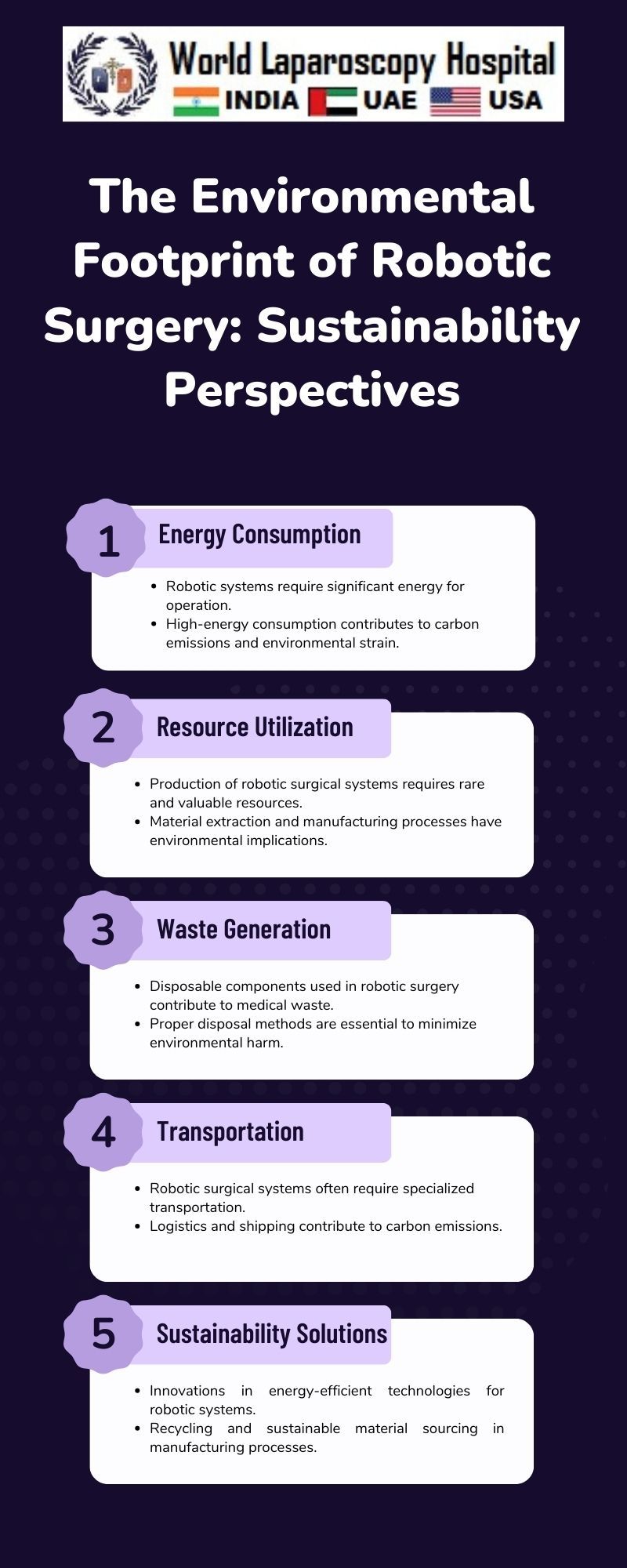Introduction
The Environmental Footprint of Robotic Surgery: Sustainability Perspectives
Robotic surgery, a cutting-edge medical innovation, has revolutionized the field of surgery by offering enhanced precision and minimally invasive procedures. However, behind its promising medical advancements lies a hidden environmental footprint that demands attention. In this article, we delve into the sustainability perspectives surrounding robotic surgery, exploring its environmental impacts, challenges, and potential pathways toward greater eco-consciousness.

Understanding Robotic Surgery
Robotic surgery involves the use of advanced robotic systems to assist surgeons in performing intricate procedures with unparalleled precision. These systems typically consist of a console where the surgeon controls robotic arms equipped with surgical instruments, offering greater dexterity and control compared to traditional surgical methods.
Environmental Impacts
While robotic surgery brings numerous benefits in terms of patient outcomes and recovery, its environmental impacts cannot be overlooked. The production, maintenance, and disposal of robotic systems contribute to carbon emissions, resource depletion, and waste generation.
Energy Consumption:
Robotic surgery systems require substantial energy for operation, primarily in the form of electricity. This energy demand not only adds to operational costs but also increases carbon emissions, especially in regions where electricity generation relies on fossil fuels.
Material Usage:
The manufacturing of robotic surgical systems entails the extraction and processing of raw materials, including metals, plastics, and electronic components. This process consumes resources and generates waste, contributing to environmental degradation.
Single-Use Instrumentation:
Many robotic surgical procedures utilize disposable instruments and accessories, which contribute to plastic waste accumulation. While these single-use items are crucial for maintaining sterility and reducing infection risks, their disposal presents a sustainability challenge.
Electronic Waste:
As robotic surgical systems evolve and newer models are introduced, older systems become obsolete and are often discarded. Proper disposal of electronic components is essential to prevent environmental contamination from hazardous materials such as lead, mercury, and cadmium.
Challenges and Opportunities
Addressing the environmental footprint of robotic surgery requires a multifaceted approach that balances medical innovation with sustainability principles. Several challenges and opportunities must be considered to mitigate the environmental impacts associated with this advanced medical technology.
Design for Sustainability:
Manufacturers of robotic surgical systems can prioritize sustainability in product design by incorporating eco-friendly materials, optimizing energy efficiency, and designing for recyclability and reusability. Collaborations between engineers, designers, and environmental experts are essential to integrate sustainability considerations into the design process.
Lifecycle Assessment:
Conducting comprehensive lifecycle assessments can help identify the environmental hotspots associated with robotic surgery, from raw material extraction to end-of-life disposal. By quantifying the environmental impacts at each stage of the product lifecycle, stakeholders can implement targeted strategies to minimize resource consumption and emissions.
Sustainable Procurement Practices:
Healthcare facilities can adopt sustainable procurement practices by prioritizing the purchase of energy-efficient robotic systems, minimizing single-use instrument usage through sterilization and reprocessing programs, and selecting vendors committed to environmental stewardship.
Technology Innovation:
Continued innovation in robotic surgery technology holds the potential to reduce its environmental footprint. Advancements in renewable energy integration, battery technology, and materials science can enhance the sustainability profile of robotic surgical systems, making them more energy-efficient and environmentally friendly.
Education and Awareness:
Raising awareness among healthcare professionals, patients, and policymakers about the environmental impacts of robotic surgery is essential for driving positive change. Training programs can incorporate sustainability principles into medical curricula, empowering future generations of healthcare providers to prioritize environmental responsibility alongside patient care.
Case Studies and Best Practices
Several healthcare institutions and organizations have already begun implementing sustainable practices in robotic surgery, serving as models for others to follow.
Cleveland Clinic:
The Cleveland Clinic has implemented a Greening the Operating Room initiative aimed at reducing waste and energy consumption in surgical procedures, including those utilizing robotic surgery systems. Through initiatives such as recycling programs, energy-efficient equipment upgrades, and staff education, the Cleveland Clinic has demonstrated a commitment to sustainability in healthcare delivery.
Intuitive Surgical:
As a leading manufacturer of robotic surgical systems, Intuitive Surgical has taken steps to minimize the environmental impact of its products. The company has implemented eco-design principles in product development, established recycling and refurbishment programs for obsolete systems, and prioritized energy-efficient manufacturing processes.
Conclusion
Robotic surgery offers unprecedented precision and patient benefits but comes with a significant environmental footprint that cannot be ignored. By adopting sustainable practices across the entire lifecycle of robotic surgical systems, from design and manufacturing to procurement and disposal, stakeholders can mitigate environmental impacts while continuing to advance medical innovation. Navigating the environmental landscape of robotic surgery requires collaboration, innovation, and a shared commitment to balancing healthcare excellence with environmental stewardship.
